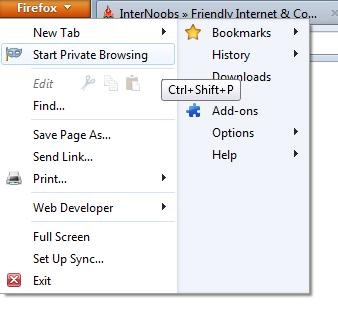Private browsing is all the rage with browsers these days. Once you go into private browsing mode, you can traverse the internet without leaving a trail. Your history? Deleted. Your cookies? Destroyed. Your bookmarks and non-private history? Preserved for when you come back to the surface.
Even if you've got a clean conscience, there are advantages in keeping your online activities to yourself. Perhaps you're planning a surprise party for the family member that you share a computer with. Perhaps you're on a computer at the office and don't want your co-workers poking around in your business. Or perhaps you just have concerns about someone sneaking into your top-secret bunker and finding out about your search history ("time travel," "building wormholes," "how to + global domination"). Whatever your reason for going undercover, private browsing will help keep other people from being nosy.
Now, while private browsing is useful, it's not all powerful. Private browsing won't protect you from keyloggers, tracking programs, nasty viruses after your personal info, or government surveillance efforts. But as far as the average Joe is concerned, your private online activities will remain shrouded in mystery.
As with most browser-related things, enabling private browsing is all a matter of knowing where to look. I'm going to show you how to fly under the radar with Firefox 4, Google Chrome and Internet Explorer 9. Each set of instructions has a few handy screenshots to help you along.
Firefox 4
Open up the bright orange Firefox menu in the top-left corner of your browser window. Click "Start Private Browsing."

If this is the first time you've used Private Browsing, you'll get the following message. Go ahead and check that box to avoid getting the same message every time.

Once you've got Private Browsing active, the orange Firefox button will turn purple, and the address bar will be marked with an icon of a mask.

To stop Private Browsing, go back to the Firefox menu and click "Stop Private Browsing". Your non-private tabs will appear right where you left them.

Now, if you've currently got the Menu Bar active within your Toolbar settings, you won't see an orange button in the top-left corner. Instead, you'll find the "Start Private Browsing" option within the Tools menu. Everything else will work exactly the same way.
Google Chrome
Open up the Settings menu. It's the little wrench-shaped icon in the top-right corner. Click "New incognito window." That's right. You're about to go incognito.

Chrome will open up a separate window for your private browsing needs. Your original window will remain in the background. Appropriately enough, Incognito mode is marked with a little fedora-clad gumshoe.

To return to normal browsing, just close the Incognito window.
Internet Explorer 9
See that little gear in the top-right corner? Click it.

Next, mouse-over the Safety menu. Click "InPrivate Browsing."

Like Chrome, IE9 will open a new browser window, leaving your open tabs intact. You'll know the InPrivate browsing window by the dark blue "InPrivate" icon to the left of the address bar.

Close the InPrivate window whenever you're ready to stop being sneaky.
Just updated your iPhone? You'll find new emoji, enhanced security, podcast transcripts, Apple Cash virtual numbers, and other useful features. There are even new additions hidden within Safari. Find out what's new and changed on your iPhone with the iOS 17.4 update.






























10 Comments
Thanks Becky. Great article.
For Opera:
1) Right click the "New tab" button
2) Select: "New private tab"
Now you have a private tab that wont leave traces on your PC.
To stop browsing private:
1) Close the private tab you opened
Done.
If you are using Firefox 4.0,, you use the top bar (file edit,vieuw etc.
Go to "tools" and you find the instructions for starting or stopping the private browsing.
Ctrl+Shift+P works too.
this works faster !
This helped alot. Thanks. I found this link saying that its not safe using the inprivate links ? That its possible to see on the server end what is happening. Is this true ? http://cognitiveanomalies.com/how-inprivate-browsing-works/
Is it ony the local computer that is protected ?
Firefox *SUCKS*. you cant even open an in-private mode window and another normal window.
I prefer firefox because chromium tends to leak information like dns requests. Not to mention... chromium's proxying abilities are minimal if not non existant.
use a stable version of chrome. chromium *obviously* has some security issues.
I have a question for ya,
If you are on a mobile (android), on wifi in a private browser, will the router still track all of your history. Or will it be like 100% private from wireless routers and others (unless your like law enforement and you can see it)
Cheers guys,
I generally use private browsing when I'm accessing internet via somebody else system. It's certainly a easy way to leave no details about your surfing and helps your data from getting hacked.
Having no ideas.
Share Your Thoughts